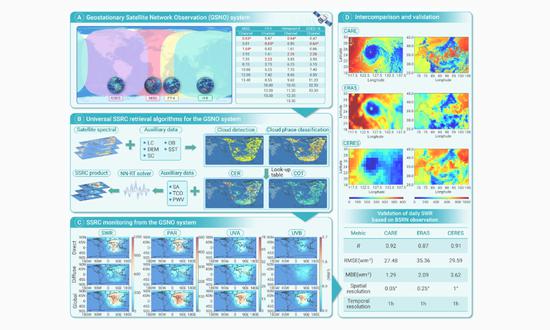
The geostationary satellite network observation (GSNO) system and its achievement map (Photo/CCTV)
Chinese scientists, in collaboration with several international research institutions, have led the construction of a high-precision surface solar radiation monitoring system on a near-global scale.
The joint research led by researchers from the State Key Laboratory of Remote Sensing and Digital Earth of the Aerospace Information Research Institute under the Chinese Academy of Sciences, in collaboration with scientists from Japan, France the UK has recently been published in the international academic journal The Innovation.
The system is expected to provide accurate data support for clean energy utilization, crop yield estimation, climate response and public health.
By combining observations from multiple geostationary satellites, the geostationary satellite network observation system achieves the highest spatial and temporal resolution for surface solar radiation detection on a near-global scale, while simultaneously enhancing detection accuracy, China Central Television reported on Monday.
Surface solar radiation is the total shortwave solar radiation reaching Earth’s surface, including UV, visible and infrared light. It powers life on Earth and influences climate, agriculture and solar energy use.
Satellite remote sensing, characterized by its robust data continuity and extensive coverage, stands out as one of the most effective means for monitoring changes in surface solar radiation. This technology is akin to installing a “scanner for sunlight” on the Earth’s surface, enabling precise monitoring of surface solar radiation changes. It provides accurate data support for clean energy utilization, agricultural yield estimation, climate change response and human health.
Building on a 2023 near-real-time remote sensing monitoring system, the team has overcome spectral and geometric challenges in multi-satellite coordination, and achieved the integrated application of the latest generation of geostationary satellites, including Chinese Fengyun-4 satellite, Japanese Himawari-8 satellite, the European Meteosat Second Generation geostationary meteorological satellites, and the US’ Geostationary Operational Environmental Satellite-16.
The GSNO system has successfully achieved continuous, seamless monitoring of surface solar radiation across Asia, Europe, North America, South America, Oceania and Africa, overcoming gaps in polar orbiting satellite frequency and single-satellite coverage – marking a shift from regional to near-global observation.
The GSNO system currently delivers near-global surface solar radiation monitoring data with a spatial resolution of 5 kilometers and an observation per hour. It offers detailed and high-precision support for local meteorological disaster monitoring and photovoltaic power station site selection.
In the future, the GSNO system will be expected to support global solar energy resource assessment and contribute to the distribution of clean energy under China’s dual carbon goals. Its data will support crop yields and carbon sink estimates, while its UV module could assist public health research.


















































 京公网安备 11010202009201号
京公网安备 11010202009201号